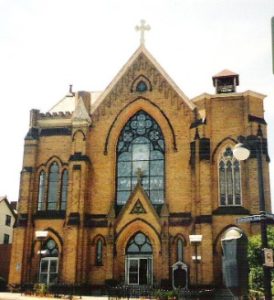My memory of why the hardwood floors were carpeted is as follows. In the 60’s most adults did not wear tennis shoes or sneakers or the casual soft soles people wear today. Women and men wore shoes with hard soles and heels. Men especially wore those black dress shoes which left black heel marks on the light-colored hardwood. It needed constant upkeep. Linda and I were enlisted to keep the floors looking good. It was a pain! Today people cover hardwood floors with polyurethane or buy floors already treated. Also, people might take off their shoes today. Believe me, in the 60’s, people would have been highly insulted if you asked them to remove their shoes! How times have changed. 😊
Month: May 2020
Seminary Life
Last updated 27 February 2021
As I look back on my elementary school years, I was both smart and gullible. I was susceptible to the suggestion that I was destined to be a priest. At 13 I knew what my future was going to be! Thus, I applied and was accepted to the seminary at St. Vincent Scholasticate in Latrobe. Some 45 miles from home. The Scholasticate was run by the Benedictines at the Saint Vincent Monastery. The campus consisted of the monastery, a college and a high school, along with all the usual accoutrements of a religious and educational enclave. The high school was also divided into separate divisions where students attended the same classes. Some students of the Preparatory School lived off campus and some in the dormitories. About 1200 boys attended the prep school. The college had both secular and religious students,seminarians, who attended classes together. Not all seminarians were intending to be Benedictine priests.
to be a priest. At 13 I knew what my future was going to be! Thus, I applied and was accepted to the seminary at St. Vincent Scholasticate in Latrobe. Some 45 miles from home. The Scholasticate was run by the Benedictines at the Saint Vincent Monastery. The campus consisted of the monastery, a college and a high school, along with all the usual accoutrements of a religious and educational enclave. The high school was also divided into separate divisions where students attended the same classes. Some students of the Preparatory School lived off campus and some in the dormitories. About 1200 boys attended the prep school. The college had both secular and religious students,seminarians, who attended classes together. Not all seminarians were intending to be Benedictine priests.
Except for the time in and between classes, there was little mingling between the two student bodies. The Scholasticates shared an area of the monastery set aside for them. The Scholasticates, referred to by many as “Skillies”, were controlled and segregated from the general community. Skillies had their own study halls, dormitories and dining hall. We did have the same dress code as the preparatory school, coats and ties.
In my last year, there were 24 other high school students. There were three study halls, one for freshmen and sophomores, one for juniors and seniors, and one for the freshmen and sophomore collegians. The approximately 20 desks in the high school study halls were assigned to the students at the beginning of the school year. The college study hall was smaller and probably had 10 to 15 seats. During study hall, only study was permitted. Study hall hours were from 4:00 to 5:00 PM and 7:00 to 9:00 PM Sunday through Thursday. I do not recall the hours on the weekends. There was always a study hall proctor. The proctor had taken temporary vows and wore the habit of the Novitiate and was a college junior or senior. Because I usually finished my homework in short order, on a few occasions I was caught reading a book that did not qualify for study. I don’t remember the punishment, but I’m sure it was minor, such as having to write a 1,000 word essay on the book I was surreptitiously reading.
There were two dormitories, a large open bay for the high school students and a smaller one for the freshmen and sophomore collegians. The day started with a 5:30 AM lights-on and an announcement that it was time to get moving. We’d file into the communal bathrooms, washed our faces and hands, brushed our teeth, donned our clothes. Showers were availabe only once a week of Friday or Saturday.
By 6 AM we were headed out the door on our way to the chapel. At the chapel, the Matins (morning prayers) were said and a Mass was held. From there we walked, always in silence honoring the “Silentia Magnum” signs, through the monastery halls toward the Scholasticate’s refectory for breakfast.
The entire group of Scholasticates and its staff had the refectory to itself. The meals were prepared by Benedictine nuns who had come from Germany many years earlier. When referring to the nuns, their German title “Svester” was used. Actually, for institutional food the meals were pretty good. We were served the same food as the monks and priests who lived and taught at the college and high school.
The Scholasticate had an additional set of rules governing conduct. As I recall, there were 12 rules; two of them had a long lasting effect on my life. The first of those rules stated that smoking was not permitted for students under the age of 16. Of course most students headed to the bookstore to buy their first pack of cigarettes. On our lunch break on school days, we would exercise by walking around in the cemetery. Those of smoking age would, of course, take a smoke break. The smoking habit stayed with me until I gave it up in 1969.
The other rule forbade students from leaving the campus without permission. It was the violation of that rule that ended my seminary days.
